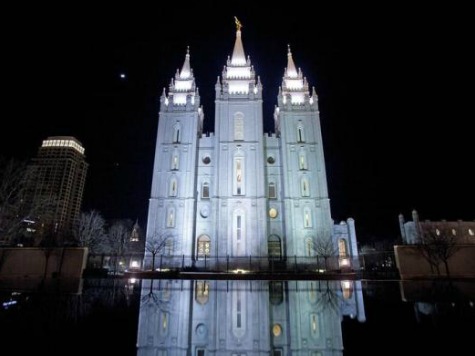Rising from an expansive 15-acre plot just 11 miles from Saint Peter’s Basilica, the Mormon’s first temple in Italy shines tall and white.
The 140-foot temple, begun in 2010, will be the largest Mormon temple in Europe, and is scheduled to be inaugurated next year. The choice of 2015 is not a random date, but falls on the fiftieth anniversary of the first Mormon missions in Italy, an activity that has brought numbers of the faithful from just 1,400 in 1970 to nearly 30,000 today.
According to local Stake President Massimo De Feo, the construction responds to a real need felt by Italian Mormons, who currently have to travel abroad if they wish to do temple work. Mormon archives in Italy, however, put most of their members in the north, and document only 2,117 Mormons living in Rome and the surrounding region.
Not everyone has seen this expansion as a good thing. Reactions from Catholic church officials have been divided, with some seeing the construction as worrisome and others looking at it as an opportunity.
According to Dr. Massimo Introvigne, Italy’s premier expert in religious movements, a recent book by American scholar Michael W. Homer called Joseph’s Temples would show conclusively that Mormon doctrine and ritual are largely derived from the Freemasons. The ties of Mormonism to Freemasonry may explain some of the negative reactions to the project from some Catholic church leaders, since the Catholic church has long been hostile toward Freemasonry. More than a century ago, Pope Leo XIII described the Masons as “partisans of evil” and said they were “boldly rising up against God Himself.”
“I was not aware the Mormons were building this temple on the outskirts of Rome, but I do know that the Mormon Church is very rich, endowed with enormous resources coming from the United States,” says Cardinal Elio Sgreccia, former president of the Pontifical Academy for Life and a celebrated bioethicist.
“It’s no sin to have economic means, but this new Mormon center, the biggest in Europe, will certainly pose a problem for ecumenism,” he said.
“On the one hand, the construction of this new temple has created jobs, and this is a good thing,” the cardinal continued, “but for ecumenism, that is, dialog and a search for the unity of all Christians, their presence in Rome is definitely not constructive.”
Sgreccia does not speak for everyone in the Vatican. Another prelate, Archbishop Gianfranco Girotti, regent emeritus of the Vatican department known as the “Apostolic Penitentiary,” welcomes the arrival of the Mormons and sees this as an opportunity for ecumenism.
“Thanks to the teachings of the Second Vatican Council, Catholics and other Christian confessions have come to understand the fundamental importance of religious liberty,” he said. “And this applies to everyone, including the Mormons,” he added.
“That’s why every person of good will who wishes to see ecumenism progress among all Christian communities can’t be unfavorable to the opening of a new Mormon temple in Rome,” says Girotti, who is unafraid of Mormon proselytism. “Their presence will serve to stimulate Catholics in bearing witness to their faith in the Christ of the Gospels, whose vicar is the Pope,” he added.
In fact, according to Girotti, between Catholics and Mormons, there is “common ground on which to dialog and work together, such as the defense of the family built upon one man and one woman united in marriage, a decisive ‘yes’ to life, and gospel faithfulness.”
Another official who sees no Mormon peril is Msgr. Enrico Feroci, the diocesan director of Caritas in Rome, the department that takes care of the church’s aid to the needy.
“Everyone has a right to make their own faith choices and to adopt the necessary means to profess it, such as building places of worship,” he noted.

COMMENTS
Please let us know if you're having issues with commenting.